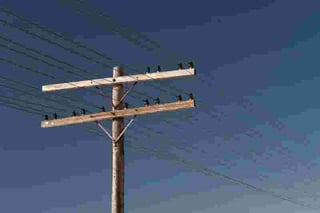The 4 Types of Utility Pole Transfers
 There are many reasons that cause double wood, which is the existence of two poles where only one should be.
There are many reasons that cause double wood, which is the existence of two poles where only one should be.
Regardless of the cause, double wood represents potential hazards or violations, and a hassle for utility pole owners and municipalities alike.
Removing double wood is a primary issue for utility pole owners across the nation. Before an equipment transfer can be put into motion, someone must designate what type of transfer it is likely to be, generally by visually surveying the situation in the field. There are four different pole transfer designations.

#1 Simple Pole Transfer
The most basic transfer. Equipment transfer and pole removal can be performed in a minimal amount of time with a basic line crew and truck, without the heavy equipment or complicated splicing. A simple transfer typically includes copper splicing of drops and c-wire, as well as simple underground work that can be performed with a hand shovel.
#2 Complex Pole Transfer
As its name implies, a complex pole transfer requires a little more work, and in some cases the use of heavy machinery and specialized knowledge. This designation refers to any utility pole transfer that requires splicing of copper cable other than drop cable or c-wire, splicing of fiber optic cable and/or underground work that cannot be completed with a hand shovel.
#3 Idle Pole Transfer
An idle pole is just the thing joint use departments, city governments, and pedestrians alike do not like to see in a landscape—a pole with no attachments and no obvious use, standing next to a fully functioning field asset. However, to a pole owner, this type of transfer is close to a best-case scenario in that it means less work for the company’s crews. This designation means that all attachments, aerial cables, and/or plant facilities have been removed, and it is a bare pole waiting for removal. Again, even without equipment attached, this type of pole can be a liability as its structure may be damaged, necessitating the initial transfer. A damaged pole could fall, causing damage that the pole owner would be liable for, regardless of who left the pole idle.
#4 Corrected
A corrected designation means all has been completed and all is well in the pole world—all transfers have been made and construction is finished. Noting this in a pole owner’s joint use management solution software will ensure that the full circle of pole life has been recorded and acknowledged, and that all records are up to date on that particular asset.
The Right Designation Will Help Remove Double Wood, for Good
Knowing pole designations is important, but knowing how to fix double wood instances is even more so. The key: finding out for sure what state your poles are in, and correcting any issues as soon as possible. Getting a good look at each pole via field inventory, as well as keeping good records of each pole's status will help you say goodbye to double wood.
Find out the Top 6 Reasons to Tackle Your Double Poles Now

Comments